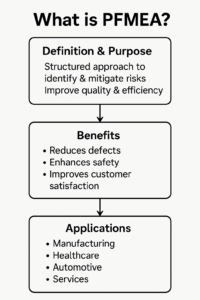Introduction
Process Failure Mode and Effects Analysis (PFMEA) is a structured method used to identify, evaluate, and mitigate risks in a process. It ensures process stability, enhances product quality, and improves operational efficiency. This comprehensive guide will take you through a detailed 6-hour course format, covering both foundational and advanced aspects of PFMEA.

Chapter 1: Understanding PFMEA
Lesson 1: What is PFMEA?
- Definition and purpose
- History and evolution of PFMEA
- How PFMEA compares to other risk management tools
Lesson 2: Benefits of PFMEA
- Enhancing quality and reducing defects
- Cost reduction and financial benefits
- Terminologies
- Failure Mode and its impact on business operations
- Effects of Failure: Safety hazards, f
- Compliance with industry standards (ISO 9001, IATF 16949, etc.)
- Case studies on successful PFMEA implementation
Lesson 3: Key
- inancial implications, delays
- Severity (S), Occurrence (O), Detection (D) – Detailed explanation and examples
- Risk Priority Number (RPN) – Calculation and practical application


Leave a Reply